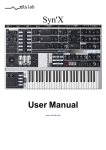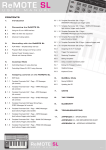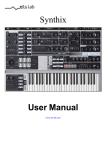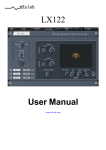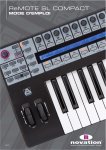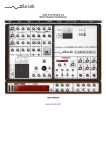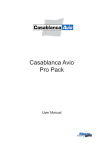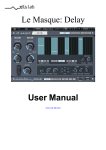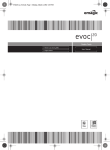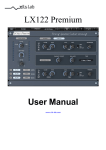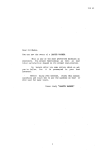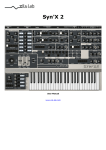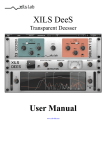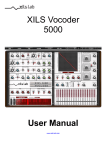Download miniSyn`X User Manual - XILS-lab
Transcript
miniSyn'X User Manual www.xils-lab.com Table of contents 1 INTRODUCTION................................................................................................................................................4 2 FEATURES.......................................................................................................................................................... 5 3 INSTALLATION................................................................................................................................................. 6 3.1 SERIAL NUMBER.................................................................................................................................................. 6 3.2 WINDOWS (XP, VISTA, WINDOWS 7)................................................................................................................. 6 3.3 MAC (OSX 10.5 AND LATER).............................................................................................................................. 6 4 QUICK START.................................................................................................................................................... 7 4.1 LAUNCH, PLAY................................................................................................................................................... 7 4.2 TOOLBAR........................................................................................................................................................... 7 4.3 QUICK VIEW...................................................................................................................................................... 8 4.4 ADJUSTING THE INSTRUMENTS PARAMETERS (KNOBS, SWITCHES)................................................................................. 8 5 PRESET MANAGEMENT................................................................................................................................. 9 5.1 MAIN TOOLBAR.................................................................................................................................................. 9 5.2 PRESET MENU................................................................................................................................................... 10 5.3 SORT MENUS : HOW TO FIND THE RIGHT PATCH FOR YOUR TRACK QUICKLY.................................................................. 12 5.3.1 Sorting Menu: Additional Functions .................................................................................................... 13 5.4 A/B COMPARISON SLOTS..................................................................................................................................... 14 6 MINISYN'X GLOBAL PARAMETERS : LAYERS, MODES, STEREO, POLYPHONY, EFFECTS....15 6.1 LAYER MODES : SINGLE, SPLIT AND DOUBLE....................................................................................................... 15 6.2 GLOBAL PARAMETERS TIED TO LAYERS MODES : STEREO, BALANCE, POLYPHONY..................................................... 16 6.3 LAYERS MANAGEMENT : COPY, EXCHANGE, GANG EDIT MODE.............................................................................. 16 7 EASY SOUND DESIGN WITH THE LAYERS : SMART LOAD, RANDOM LOAD, AND LOAD LAYER FUNCTIONS.......................................................................................................................................... 17 8 MINISYN'X MODULES DESCRIPTION...................................................................................................... 18 8.1 SYNTHESIS........................................................................................................................................................19 8.1.1 Oscillators............................................................................................................................................. 19 8.1.2 Oscillators synchronization................................................................................................................... 20 8.1.3 Multimode Filter.................................................................................................................................... 20 8.1.4 Envelope Generators............................................................................................................................. 21 8.1.5 Noise Generator.................................................................................................................................... 22 8.1.6 LFO........................................................................................................................................................22 8.1.7 Glide/Portamento and Velocity Modulation .......................................................................................... 23 8.1.8 Joystick (Bend/LFO).............................................................................................................................. 24 8.1.9 Master ................................................................................................................................................. 25 8.2 SEQUENCER...................................................................................................................................................... 25 8.2.1 Sequencer display module..................................................................................................................... 26 8.3 VIRTUAL KEYBOARD...........................................................................................................................................27 8.3.1 Chorus................................................................................................................................................... 27 9 OPTION MENU.................................................................................................................................................28 9.1.1 Main....................................................................................................................................................... 28 9.1.2 Remote Control with Midi Cc ............................................................................................................... 28 9.1.3 Display Options..................................................................................................................................... 29 9.1.4 Misc....................................................................................................................................................... 30 10 CREDITS.......................................................................................................................................................... 30 1 Introduction Thank you for choosing the miniSyn'X ! The miniSyn'X is a virtual instrument based on the architecture of one of the most iconic of all vintage polyphonic synthesizers. So revered that it is still in use today by some famous synthesizer masters. We at XILS-lab do our best to offer you authentic recreations of these great synthesizers and then take it even further : What can be done with today’s computers allows us to take these emulations beyond what was feasible when these products were first created. Our goal is to be true to the original in sound and modulation routings and then add features that were just not before possible. And often that are not feasible on any other synthesizer, be it hardware or software. Ring Modulation, Cross Pulse Width Modulation and Hard Synchronization between the oscillators and an unique sophisticated glide circuit allow the recreation of some of the patches that made this synthesizer a must have in the ancient times. If you not yet developed your skills as a sound designer, we have included more than 200 presets especially designed for the MiniSyn’X by professional sound designers. So you can fuel your synthesizer dreams as soon as you load the miniSyn'X into your DAW. Please enjoy this very powerful sound creation tool. We love what we do and we want you to get the most enjoyment you possibly can from our labors. We also want to hear from you. So “like” us on Facebook conversation http://www.facebook.com/XILSLabs and join in the -4- 2 Features The miniSyn'X offers: Oscillators ( Up to 10 oscillators per patch ) • Two aliasing-free oscillators providing saw, triangle, pulse or square wave forms. • Pulse Width modulation on all oscillators waveforms • Hard synchronization between the two oscillators • Ring-Modulation, Pulse Width Cross Modulation between the two oscillators Filters ( Up to 2 per patch ) • One multi-mode self -oscillating filter, providing 12 and 24 low pass, 6 and 12 band pass and a 12 high pass filter per synthesizer engine Miscellaneous • Advanced Glide/Portamento module • Two envelope generators (ADSR) ( Up to 4 per patch in split/Double mode ) • One Cumulative Waveform MIDI syncable polyphonic LFO ( 2 per patch in Split/Double mode ) • One sine monophonic LFO ( Assigned to the Joystick ) • One 128 steps polyphonic sequencer ( 4 Lines ) • Fat and warm 3 modes Chorus Structure and ergonomy • 2 independent identical synthesizer engines, that can be associated in 3 modes ( Single, Double, Split ) • Easy Sound Creation Module ( Smart Load ) • Gang Edit Mode ( In Double & Split Modes ) • Adaptative UI design ( YOSWYN : You only see what you need ) • Entirely automatable via Midi Cc Control • Two GUI sizes: 1024 and 2048 pixels width The miniSyn'X is available in the following formats: • • Mac OSX 10.5 and later: VST, Audio Unit, RTAS (Pro Tools 7.0 and later), AAX Windows 7, XP and Vista: VST, RTAS (Pro Tools 7.0 and later), AAX Minimum system requirements: 1 Gigabyte of RAM and a 2 GHz processor. The miniSyn'X is a plug-in and is not available as a standalone application Notice: The screen resolution must be set at least to 1024 pixels width. -5- 3 Installation 3.1 Serial number The miniSyn'X only uses a simple serial number protection. When you launch the miniSyn'X for the first time, it will ask for this number. After submitting, you must close the plug in and reload it it once in your host to complete the registration. This serial number will never be asked for again, even when installing updates. Tip: It is always a good idea to back up this serial number, or to print it, in case you should have to reinstall miniSyn'X (i.e. if you encountered a HD crash for example, or have to reinstall your OS). 3.2 Windows (XP, VISTA, Windows 7) To install miniSyn'X on Windows XP, Vista or Windows 7, launch miniSyn'X installer file. Please download the latest version from the XILS-lab website. http://www.xils-lab.com/pages/miniSynX_Downloads.html Once you have accepted the license agreement, you will be asked to select the installation directory. A destination directory is provided as a default. Presets and various files, like this manual, used by miniSyn'X will be stored in this directory. Please note that this location is different from the VST install directory, which you will need to specify in the next step of the installer. Once the installation directory is specified, you will be asked to select the VST plug-in directory, with a suggested default location. Keep this default directory if you do not use the VST version. Important notice for Vista or Windows 7: be sure to use a folder write enable and owned by the user (do not use “c:/program files” for instance). Otherwise you will have to run your music application with “administrator rights”. The RTAS plug-in and its table control management Pro-Tools are directly copied into the following directory: C:\Program Files\Common Files\Digidesign\DAE\Plug-Ins 3.3 Mac (OSX 10.5 and later) To install miniSyn'X on a computer equipped with Mac OSX 10.5 or later, download the latest version from the XILS-lab website to make sure you have the latest version of the software. http://www.xils-lab.com/pages/miniSynX_Download.html Then launch the install program, miniSynX.pkg, and follow the instructions. Warning: the install program will ask you for your system password. The various files of miniSyn'X will be copied into the following directories: Library/Application Support/Digidesign/Plug-Ins Library/Audio/Plug-Ins/Components Library/Audio/Plug-Ins/VST/ Library/Application Support/Documentation/XILS-lab/miniSynX ..users/username/Library/Preferences/XILS-lab/miniSynX -6- 4 Quick Start Launch, Play 4.1 When you open the miniSyn'X in your host, an Init preset is loaded. It is a simple two-oscillators sound, which can be seen as a basis for your sound design. You can directly use this preset, a simple, or load one of the more than 250 factory presets provided. To browse the factory-preset library, just select a category of instruments, using the bank drop down menu at the left of the miniSyn'X Tool Bar. (See Picture Below) You can then use the up and down arrows located at the right of the preset name, or open the whole bank list by clicking on the triangle located at the left of the preset name (See Picture Below) Note: We have also provided different Init Patches, which can be seen as a good basis to begin to design new presets. 4.2 Toolbar Note: The toolbar at the top of the interface allows you to load or save presets, make a comparison between settings A and B, or modify the options. These functions are described in detail later in this manual. Click on the PRESET arrow to show the available presets in the current sorted group. Please note that selecting a new preset without saving your current settings will erase any changes you have made to those settings. Click on the sort arrow button to display the current sorted group and to choose the preset within it. You can sort presets by: Author, Feeling, Type, Style, Bank or Projects. Please note that the miniSyn'X will display presets by instruments categories (Type) by default. Click on the sorting label over the sorted group name, to sort your preset according to your preferences. Please note that the miniSyn'X’s powerful Preset management is fully detailed in chapter 6 of this manual. -7- 4.3 Quick View 4.4 Adjusting the instruments parameters (Knobs, switches) On the miniSyn'X, most sound parameters, like the pitch of an oscillator, or the filter’s Cut-Off frequency are controlled using Knobs. To adjust the parameters of the miniSyn'X with the mouse, you have two axes: horizontal and vertical : Both will give the same results. • To increase a parameters value, click and drag the knob to the right, or to the top • To decrease a parameter value, click and drag the knob to the left or, to the bottom. If you right-click on a parameter, or if you hold shift while clicking, you can adjust the parameter with fine precision (Tip : the ? button of the toolbar opens an info panel summarizing these shortcuts). Keyboard shortcuts In addition we have provided different soft keys combination to perform several very useful tasks: Windows: -8- • • • CTRL+left click: reset parameter to its default value. CTRL+right click or CTRL+Shift+left click: initialize the default value of the parameter. Win+Alt+CTRL + click: open the MIDI Control panel, with the parameter already selected. OSX: • • • Apple+left click: reset parameter to its default value. Apple+Shift+left click: initialise the default value of the parameter Apple+Alt+CTRL + click: open the MIDI Control panel, with the parameter already selected. Note: Other GUI elements and controls, like the LED Switches, or the dropdown menus, will be described in the following sections of this manual, when you’ll need to use them. The switches are simpler: just left click to change their state. A right click will change the state only while the button is pressed, and return to the previous state when it is released. When a parameter is chosen via a drop down menu, just click on the button or label and select the item. 5 Preset Management 5.1 Main Toolbar In the toolbar you can find two buttons, displaying the category name (Bank, Author, Type, Style, Feeling or Project), which open the sort management menus. The two first text fields show the current sorting group and the third shows the current preset. Clicking on the arrow on the left of the category or preset names opens the corresponding menus. Note: When a parameter is modified, the name of the preset is followed by a *, indicating that the current settings of the miniSyn'X no longer matches the stored preset. When you want to save a modified preset, click on the Save or Save As button. -9- In order to prevent you from erasing them, the Factory presets cannot be modified. When you edit a Factory preset, the Save button will be grayed, and you will have to use the Save As function to save it in another bank. If you edit any other preset than a Factory one, the Save and Save As function will both be available. The main difference is that the Save function will save the preset under its current name, and with its current tags, overwriting the previous incarnation of the preset, while the Save as function opens a dialog box where you can modify the name of the preset, the bank in which it will be stored, and all its tags The settings of the miniSyn'X are then saved in the currently displayed preset, and the * disappears. Click on the Save As button to save this preset with another name and/or to other sorting groups. 5.2 Preset menu Click the Preset arrow button to open the preset menu. Here you can choose and load another preset from the current sort groups into the miniSyn'X. In this menu, other actions are also available: Delete Preset: use this to delete the current preset (a popup confirmation window appears). This option is only available if the current preset is not a factory one. - 10 - Export Preset: Use this function to export the current preset in an external file (.esyx format). This file can be imported later as a new bank. It always makes sense to back up your presets on external media. Open preset Information (or click on SAVE AS): opens the following preset information window where the name and all other information related to the current preset can be displayed or changed. In this window you can modify the Name of the preset, specify the Bank in which the preset will be saved, and also enter information in the other fields: • • • • • AUTHOR (Your name, mostly used by Sound Designers for factory presets), Type (Category of the instrument like Keys, Leads, Basses, also) Style (Musical Genre), Feeling (Cold, warm, soft) and finally Project (My Song, My_Live_Project). You can also see its creation date and the last update date. To modify a preset name, click in the NAME field and enter the new preset name this will also save all the current settings. To change presets information, click on the display, this will open a list when you can select one of the existing items, or create a new item for this criteria ( Create a new BANK, or a new CATEGORY/TYPE of instrument etc ). Note: You can add a new item in any category, and therefore create custom banks, custom styles, Projects, categories of instruments etc. Creating Custom Tags : To add a new item in any filed, select “New….”. Which appears at the bottom of the list. ( Note : You may have to browse until the end of the list in order to select “new” depending on its length.) This will open A Pop Up window opens where you can enter the new name. Click Ok to validate the new name. The current preset will then be associated to this new item. Note: Please be aware that creating too many categories can also have its drawbacks, making browsing go from difficult and painful to nearly impossible. Should you create around 200 different custom instrument categories, it would become very difficult to browse the library using the Style sorting. Once you have filled all the desired/required fields: - 11 - SAVE AS: Will save the current preset in the chosen Bank, with its new (or unchanged) Name, and tagged with all the fields you filled in. MOVE TO: Allows saving the current preset in another location ( BANK) . This is handy to gather a lot of preset into a single location, or User Bank, which you can export in a single file containing all the presets you created or edited for a given project. You can also use the MOVE TO function to only change the TYPE/STYLE/FEELING of a preset, even if you don't move it to another bank CANCEL: Will cancel all operations and return to the main miniSyn'X GUI. Sort menus : How to find the right patch for your track quickly 5.3 XILS-lab synthesizer factory libraries contain several hundreds of presets, and you can buy additional soundsets on our site, or provided by 3rd party vendors, or get free soundets offered by the Xils community. With our exclusive multitag databased engine and multicriteria display, you’ll be able to find the right patch for your project much faster than if you browse all your patches in a random way The sorting menus are a unique and powerful tool. Allowing you to perform sophisticated tasks, such as displaying the preset list organized in a variety of different ways, like displaying : • • • • • All the Basses of your Sound Library All the Basses tagged with a given musical genre All the Pads made by a given Sound Designers All instruments for a musical genre like Electronica, or Funk All instruments that were recently imported in a bank (like additional sound-sets from XilsLab or 3rd party vendors) There are indeed a lot of possibilities, and we’re confident that you’ll find the best way to customize it to your personal needs. - 12 - In order to perform such selections, all you have to do is to select an item in the first sort menu. This represents the first and main criteria for the search engine. • • • • • • AUTHOR (Your name, or a Sound Designer name for factory presets), Type (Category of the instrument like Keys, Leads, Basses, etc) Style (Musical Genre), Feeling (Cold, warm, soft) and finally Project (My Song, My_Live_Project). ALL (this item is not used for sorting the preset) These primary results can then also be filtered according to the second criteria. Which can be chosen from a similar list in the secondary sort menu. Sometimes a picture is better than a lot of text, so you’ll find below an example where you can find out how to select all the basses designed by a given Sound Designer. Please note that, once you are familiar with this system, you can also perform some operations in a single click, by using the Sub Groups to choose a preset: In the picture below the primary sort menu is used to browse the different banks. Then in a factory bank, the author Xils-Lab is selected, and finally the Preset XO Bass. In this example the preset is selected in a single click operation, and the presets available in the preset list will be all the Xils-Lab presets available in the entire Factory Sound Library. Click on the row of the sorting button to open the menu used to manage this sorting group (or sub group). Here you can directly select and load any preset from any group or subgroup. 5.3.1 Sorting Menu: Additional Functions In this menu, other actions are also available: Delete: deletes all of the presets of the current group that are not factory ones. IMPORTANT: Use this function with care : If the bank does not contain any factory presets, ALL PRESETS IN THIS BANK WILL BE PERMANENTLY DELETED. Rename: modifies the current group name. Selecting this choice will open a window where the new name will be entered. - 13 - Use Factory: enables or disables the display of factory presets. Sort By: This function sorts the presets according to bank, author, project, or shows all presets (Bank Name, Author Name, Project Name, All Presets). The preset menu will show presets of the same category (same author, same project or same bank). Export Bank: This function exports a bank in the miniSyn'X’s proprietary cross platform format, (Mac and PC). The selected bank (i.e. the bank which contains the currently active preset) will be exported to a user specified location on your hard drive. Import Bank: This Function allows you to browse your hard drives to select a file and imports a miniSyn'X bank. Note : These last two choices are not available from the second sort menu. This menu provides also the possibility to change the size of the interface. This feature is the same that the one provided in the Option menu. 5.4 A/B comparison slots You can store two different versions of a patch at the same time and instantly switch from one to the other to compare them. These two settings are stored in the A and B memory slots. When you launch the miniSyn'X, the default-activated memory is A. When you load or modify a preset, this memory –A- is also modified in real time according to your edits. You can switch to B memory by clicking on the B button. To copy the current active memory content to the other memory slot, just press the button labeled -> or <-, according to the current active memory. With this A/B comparison system, you can easily have two settings and compare them in a convenient way. - 14 - Note: Please note that by default, the B memory slot, until you copy settings into it or until loading a other preset within the other memory slot, contains the same init patch loaded in the A memory when you first launch the miniSyn'X. 6 miniSyn'X Global parameters : Layers, Modes, Stereo, Polyphony, Effects The miniSyn'X, like its ancestor, provides a simple, yet powerful Dual Layer architecture. These two layers are called “Lower” and “Upper”. Each Layer ( Lower and Upper) has its own independent synthesis modules : LFO, Oscillators, Filter, Envelopes, Glide. Note : The remaining modules, Joy-Stick, Chorus, Master, are global and affect both layers. When the Lower or Upper switch is engaged ( Highlighted ), the Graphic Interface accordingly displays the state of the Lower or the Upper layer. 6.1 Layer Modes : Single, Split and Double The two synthesizer engines ( Upper & Lower ) can be combined in three ways : Single, Split and Double Single Mode : In the SINGLE MODE, only the selected layer is active ( Upper or Lower ) and you will only hear the selected layer. Please note that the SINGLE mode is determined by the status of the Double and Split button : If none of these two buttons are ON, you’re in the SINGLE mode. In the Split and Double modes, both layers ( upper and lower ) are active and can be heard The editable layer displayed in the Split and Double mode is the one selected. You can easily switch from the Lower or the Upper sound, by clicking on the Upper or the Lower switch. Double Mode : In Double mode, when the Double switch is engaged, the two layers, Upper and Lower, are played simultaneously. Therefore this mode will be preferred to create fat or wide layered sounds, with sounds in each Layer that can be identical ( to get a wider stereo scene ), Similar ( to get thicker sounds ), or completely different ( Like some keys + some strings, or a pad and some special FX ) Split Mode : In Split mode, when the Split switch is engaged, the lower part of the keyboard will play the Lower layer while the the upper part of the Keyboard will play the Upper layer. In this mode, a triangle appears above the keyboard, and you can freely move it with the mouse to set the most appropriate Split Point. The Split mode should obviously be preferred when you want two play two completely different tones on each zone of your keyboard ( Like a Bass + Keys, or Keys + Lead ) The MiniSyn’X factory library contains a lot of Split patches to get you started using this mode. - 15 - 6.2 Global Parameters tied to Layers Modes : Stereo, Balance, Polyphony Polyphony Handling : Here, you can set how many voices are enable for each layer (Range : 1 to 8). Note : If you select 1 voice polyphony, or Mono Mode, useful for basses for example, please note that the last priority law is applied. Note : If you experiment some notes stealing in some patches, please try to increase the polyphony for the layer(s) Balance : The Balance knob will only be displayed if you use the Split or Double Mode. You can use it to balance the relative output level of the two layers. Turning it clockwise will make the Upper layer louder. Anticlockwise will make the Lower layer louder. Stereo Knob : The Stereo knob controls the panning of each internal voice. When turned full left, the miniSyn'X is mono, sending the same signal to the output modules (Master, and Chorus) . When turned full right, the miniSyn'X stereo is maximum. Please note that The effect of the Stereo Knob varies according to the selected Mode In Split and Double mode : The Lower Layer is panned to the left, while the Upper Layer is panned to the Right. With higher settings or the Stereo knob, the distance between the two layers gradually increase. Tip : You can use this setting to hard pan the two layers fullleft and right for Pluck sounds for example. This is often used in Club and EDM music to get interesting results effortless. In Normal mode : the sound is randomly assigned to the right or to the left for each note. With high settings successive notes will appear randomly at the full left or right of the stereo scene. Advanced Mixing Tip : Sometimes, you’ll want more control over the two layers than what is provided by the MiniSynx stereo output, like compressing only one of the layers, or apply different effects ( Delay, Reverb etc ) to each of them. This is very easy to achieve : Just duplicate the midi part and assign another instance of the MiniSyn’X to the duplicated midi part. Load the same preset in the second instance of the MiniSyn’X. Then the first instance of the Minisynx, use the solo function on the Lower Layer, then solo the Upper Layer in the second MiniSynX instance. You can now add separate effects, Eqing or compressors separately on both Layers. Chorus The MiniSyn’X Chorus is fully stereo. This means that the right and left Chorus channels are independent, and have dedicated internal LFOs. As a consequence, using the same sound in the DOUBLE mode will increase a lot the chorus effect. The BBD Chorus effect was also responsible of the distinct sound of the hardware synthesizer. It has been very closely modeled, and has three different settings. 6.3 Layers Management : Copy, Exchange, Gang Edit Mode Copy and Exchange Functions : To make things easier we added two buttons Copy and Exchange that allow you to copy and exchange layers : Clicking on the “Exchange” button exchanges the two layer sounds, clicking on the copy button copies the selected layer to the other layer engine. Tip : Exchange Layers can be useful when you want to Switch the two layer in the stereo field. - 16 - The GANG Edit Mode : You can edit all the knobs parameters of the Lower and Upper Layers simultaneously by entering the GANG EDIT mode.( Please note that therefore the GANG MODE Button is only available when the Split or Double mode are selected ) When engaged, it will allow you to modify the two layers simultaneously, keeping the relative settings of the parameters. An example to explain the relative concept : Say you’re editing the Cut Off of the two layers in GANG MODE. Lower Layer initial level is 100, and Upper Layer value is 50. If you decrease both cut off by 40, the resulting Lower value will be 60, while the Upper Layer cut off value will now be 10. This means that the two layers keep their relative cut off difference. This also means that the GANG EDIT mode is non destructive and reversible : You can always revert to your original values ( In this example you would now add 40 to the cut off value using the GANG MODE ) TIP : The Gang Mode is especially useful when editing envelope parameters, to globally shorten the decay of a preset, adjust a sustain level while maintaining the balance between layers, or tune the attack stage according to track context. It’s also a powerful experimental sound design tool, when you tweak filters of different types for example. And finally its almost mandatory when you edit a Double Layer preset with identical sounds in each layer. This way each change you make affects both layers, and your two layers remain identical regardless of your edits. Otherwise you would have to switch and edit layers endlessly, while having to remember, or note, each parameter new value to match it on the other layer. Please note however that are excluded of the GANG MODE all the switches like : Oscillators, Filter Types, etc. Only the parameters controlled by Knobs or sliders are affected. 7 Easy Sound Design with the Layers : Smart Load, Random Load, and Load Layer functions Before we present you in detail each parameter of each synthesis module in the next section, let’s introduce the new exclusive easy patch creation tools we implemented into the MiniSyn’X. Note : These functions are only valid to create new Double or Split patches. SMART LOAD LAYER The Smart Load function uses a bit of AI to allow you to create new interesting complex and rich sounding patches. Opposite to pure random functions that you can find on some synthesizers, and that we also incorporated in the MiniStn’X, the Smart Load function will give you a high percentage of valid and inspiring patches by clicking a single button. How it works ? In the DOUBLE MODE, just click on the Smart Load button and it will replace the selected layer with another one taken from your current library, while the replacement layer will have a high probability of giving you a usable and inspiring patch. Just try it a few times on any Double Patch you like and you will see that its rare that something nice doesn’t happen after a few Smart Load attempts. The Smart Load function is also instantaneous, which adds to its charm, so you can make numerous attempts in a few seconds. RANDOM LOAD LAYER Works in an similar way to Smart Load, except it doesn’t use any AI at all, so it will load a random layer from your library to replace the selected layer. The results are therefore sometimes very surprising, but surprises will more often be less rewarding than - 17 - expected. The Load Random button will be chosen by those who like risks, enjoy extreme patches collisions, and have a bit of time to loose. Occasionally, it can give identical results to the Smart Load function. Random Load is also an instantaneous function, which adds to the fun of using it. Finally the Load Layer Function will allow you to browse your entire library of presets and choose any Layer ( Upper or Lower) of any preset to replace the selected Layer. Load Layer should be preferred by those who know exactly what they want, and wish to marry for example This_Keys with This_String_Pad. Due to the fact that you have to browse your library to select the layer you wish to load, Load Layer isn’t an instantaneous function. But you have total control on it. Note : These functions are only valid to create new Double or Split patches. They are useless for Single Patches.( But it might be a very good idea to use a Single patch you like, transform it in a Double patch by clicking on the Double Button, then use Smart Load technology to see which rabbits come out of the hat ) 8 miniSyn'X modules description The miniSyn'X contains three main sections: the first one is dedicated to the synthesis part, and is applied to each voice of polyphony, the second is dedicated to the miniSyn'X joystick with its own LFO, and the third cabinet to voices management and playing modes. - 18 - 8.1 Synthesis 8.1.1 Oscillators 16'8'...1': Octave Select Buttons TRANSP: Transpose Knob (in semi-tones up to +/- 12). Clockwise rotation of this knob increases the pitch of the oscillator up to 12 semitones; counter clockwise rotation decreases the pitch. Using the ALT keyboard modifier allows snap to semitone; otherwise, the settings are continuous and can be very fine, using the right click. LED TRANSP: When on the keyboard tracking is connected to the oscillator. Switches: Waveform Select Buttons (Triangle, Sawtooth, Square, Pulse) PWM: Pulse Width Cross-Modulation (from the other Oscillator) select button. When ON, the width is controlled by the waveform of the other oscillator. This results in a very rapid change in harmonics, close to the ring modulation effect. If no other wave form are selected, when ON, this button let the oscillator to output a width controlled pulse with the same algorithm than the Synthex. Note : The MiniSyn’X benefits from the last Xils-lab researches regarding Oscillators PWM emulation. The new algorithms developed during the two last years improve a lot the punch and clarity of the PWM compared to the Syn’X v1.0, and other soft synthesizers. Without entering into too much technical matters, the PWM algorithms are usually confronted to the same kind of challenge that the problem known as ODF filters in the digital domain. The new Xils-Lab Sync algorithm, while still not perfect, adds a lot to the overall perception of the PWM in the miniSyn’X. R.M: Ring Modulation circuit select button. This modulation can be used to produce metallic or bells sounds, depending on the waveform selected. WIDTH: Pulse Width Control (for the pulse but also the triangle or the sawtooth wave form depending on these latter settings). This knob controls the pulse width of the pulse waveform, but also the triangle leading edge or the double pulse of the sawtooth, depending on which waveform, triangle or sawtooth you have selected. LEVEL: Individual Oscillator Volume Control (before the filter) Sawtooth Label: Select a pulse width sawtooth waveform (a double edge according to the width is generated) Triangle Label: Select a pulse width triangle waveform (the leading edge of the triangle is dependent on the pulse width) Below is a view of the various available waveforms - 19 - Triangle-Triangle using Pulse Width Saw- Saw using Pulse Width Square - Pulse 8.1.2 Oscillators synchronization O2 SYNC: Forces oscillator 2 to start a new cycle whenever oscillator 1 does. This means that oscillator 2 can only play harmonics of oscillator 1. This is very useful when Oscillator 2 is modulated with an LFO, an envelope, or used through the glide (see below) DRIFT: This knob sets the accuracy of the oscillator pitch and the filter frequency cutoff as a function of time. Turning clockwise makes the oscillators unstable. This is useful for phasing effect between the two oscillators or to get a more realistic “analog” feeling. 8.1.3 Multimode Filter The miniSyn'X’s filter is an accurate dynamic multimode 4 pole self-oscillating filter. - 20 - FREQ: This knob sets the cut-off frequency of the filter. RES: This knob sets the resonance (or quality factor) of the filter. When set to the maximum the filter self oscillates. That means that it outputs a kind of sine wave even without any audio signal feeding its input. (I.e. even if both Oscillators are muted). This knob is sometimes called “emphasis” or “Q”. KEYB: set the amount of the keyboard follow Cut Off modulation. The setting can be positive or negative, allowing a direct or inverse effect. AMNT: Set the amount of the filter envelope applied to the Cut- Off modulation. The setting can be positive or negative, allowing a direct or inverse effect. Drive: Set the level of the overdrive emulation circuit. Turning totally left disables it while turning totally clockwise gives a strong driving effect. Depending where this stage is placed, pre or post filtering you can get a subtle low-end enhancement or a sort of saturation effect. [DRV Pre/Post]: Clicking on the label [DRV PRE] or [DRV POST] selects where the driving stage will stand, before or after the filter. Mode of Filter Operation select Buttons: LP12: select a Lowpass 12 db/Octave, meaning that the frequencies above the cut-off point are attenuate at a rate of 12 db/octave LP24: select a low pass 24 db/octave BP6: select a band pass 6 db/octave BP12: select a band pass 12 db/octave HP12: select a high pass 12 db/octave 8.1.4 Envelope Generators The miniSyn'X features two envelope generators (EG). The first one is dedicated to the control of filter’s Cut Off value, while the second is hardwired to control the output level stage (VCA). An envelope generator is a classic electronic module that outputs a command signal, built on four parts: ADSR (Attack-Decay-Sustain-Release). When the envelope is trigged (generally by hitting a note on the keyboard, or from the output of a sequencer or an arpeggiator) it begins with “Attack” part: From zero to the maximum level, - 21 - the EG outputs a signal which increases in a time depending on the Attack setting. Then follows the “Decay” part, while the output decreases to a level specified by the Sustain setting, during a time specified by the Decay setting. It stays on this “sustain” level as long as the EG is gated (i.e. as long as the note is held). Then when the note in off, it goes into the “release” stage, while the output continuously decreases to zero, depending on the Release setting. DELAY: set the time before the envelope enters the attack step. MIDI Sync LED: When ON, the delay time is set according to the Tempo of the application host. Attack: set the time over which the output increases. Decay: set the time the output decreases to the sustain level. Sustain: set the sustain level, maintains while the EG is gated (the note is held) Release: set the time the output decrease to zero after the note is released. 8.1.5 Noise Generator WHITE/PINK: Allows you to select either white or pink noise to be added to the oscillators in the mix going to the filter. White noise contains all the audible frequencies at equal level, while pink noise contains all the audible frequencies at equal energy, meaning the more the frequency increases, the more the level decreases. VOLUME: This controls the level of the noise added to the oscillators. 8.1.6 LFO The miniSyn'X proposes a per layer Low Frequency Oscillator, which can be used as a modulation source. - 22 - FREQ : Controls the speed of the modulation effect. DEPTH A, DEPTH B: Regulates the different amounts of the modulation, Depth A, for the oscillator pitch Modulations and the pulse width modulation of Oscillator 1, Depth B for the Filter and Output Amplifier modulation, and the Pulse Width Modulation of Oscillator 2. Waveforms Buttons: The various switches select the different available LFO waveform(s). Sine, Triangle, Saw, Ramp, Square, Random (S&H). Please note that you can select different waveform simultaneously, and can therefore build unusual and very complex LFO waveforms when combining several waveforms. Tip: This is especially handy if you wish to add some subtle movements and modulations to an instrument. Adding several waveforms to an LFO will avoid the repetitive feel of the LFO. DELAY: Set the delay time between the note ON event and the beginning of the fade in. FADE : Set the time for the Lfo output to rise from zero to the maximum level. Reset LED (Located close to the DELAY Knob ) : Reset the LFO waveform to the beginning of its cycle when a Note ON event is received Midi Synchro LED (Located close to the FREQ Knob .): Click on this led to synchronize the LFO rate to the tempo of the host. Please note that the rates will be displayed in musical notation if the sync is engaged. (LED On) Routing Select Buttons: Using these buttons the modulation setup on Depth A can be routed simultaneously to the pitch and/or pulse width of the oscillator 1 and/or 2, and on Depth B to the Filter frequency and/or the output level amplifier. Note : please note that the miniSyn’X also offers another –Global- LFO which is tied to the Joystick use. So you can have up to three independent LFOs per patch ( 1 Lower Layer, 1 Upper Layer, 1 Global ) 8.1.7 Glide/Portamento and Velocity Modulation 8.1.7.1 Glide and Portamento FLT, O1, and O2 buttons : These buttons route the glide or the portamento, which has been set up to the filter frequency or/and the oscillators pitch. GLD : The glide select button enables the glide function for the selected glide/portamento destination(s) PORT: The Portamento select button enables the portamento function for the selected glide/portamento destination(s) - 23 - SPEED: This knob sets the rate at which the glide or the portamento effect takes place. AMOUNT: This knob sets the amount, +/- 32 semitones, of the glide effect. Each time a note is triggered, the pitch of the selected destination begins from the actual note played +/- the amount of the glide, then returns to the correct pitch during a time specified the speed knob. 8.1.7.2 Velocity Velocity Modulation In this module, you can change the velocity modulation intensity over the VCA and the VCF modules. AMP : Change the amount of the velocity applied on the output level FLT: Change the amount of the velocity applied on the filter cutoff frequency 8.1.8 Joystick (Bend/LFO) The miniSyn'X offers an advanced joystick feature associated with a monophonic independent sine LFO LFO sliders : Specify the coarse and fine tune of the monophonic low frequency oscillator. (Speed) TO OSC sliders: This sets the amount of the modulation sent to both oscillators tune when the joystick is moved vertically (BEND) or horizontally to the right (LFO) Tip : Use the Joystick to add a mod wheel controlled Vibrato by setting the right rate to the LFO, then assign the Wheel led to OSC, and finally set the good modulation amount with the OSC LFO Slider TO FILTER sliders: This sets the amount of the modulation sent to the Filter frequency cutoff when the joystick is moved vertically (BEND) or horizontally to the right (LFO) Tip : Use the Joystick to add a mod wheel controlled Wah effect by setting the right rate to the LFO, then assign the Wheel led to Filter, and finally set the good modulation amount with the Flt LFO Slider WHEEL LEDs: Connect the modulation wheel to the horizontal left and/or right movement of the joystick. UPPER/BOTH/LOWER Switch: This 3 position toggle control let you choose which layers will be affected by the Joystick Modulations : Lower, Upper, or both - 24 - 8.1.9 Master MASTER: This knob controls the general output level of the miniSyn'X. TUNE: This knob controls the global tune of the miniSyn'X. It is not saved within the preset and is used to adapt the tune of the synthesizer to the other instruments. Of course it is saved within your music application project. SPRAY: This knob controls how different specific parameters micro changes are applied to the patch voices. When turned left, the settings are applied identically to all the voices, when turned right, they are applied with an exclusive analog indetermination. ( Please be aware that this global algorithm includes processing of the Oscillators pitch micro variations, possibly resulting in an unstable pitch when turned fully clockwise ) 8.2 Sequencer The miniSyn'X has a powerful polyphonic sequencer that can help you to create complex sequences and incredible special effects. The first thing to know is that this sequencer is polyphonic. That means that you can record/play up to 4 voices trigged by different sequences. The TRACK switches allow you to choose which voices will be recorded or played. Each of the 4 sequencer lines are monophonic. Sequencer clock can be synced to your Daw RECORD with the MIDI Keyboard: To record a sequence, simply push the REC button and then the number of the track you wish to write. You must also select a voice for this track. The sequencer is now waiting to record the notes you play. Each entered note will be assigned to a new step. To leave a gap, press NXT button, to make a note that lasts two steps or longer, press the NXT button while keeping the note pressed. Legato : It is possible to program “legato” sequence lines : holding down the last note while you play the next one gives legato phrasing. Once you have finished writing a sequencer line, push REC again to leave the record mode. DEL Button : If you made a mistake, the DEL button erase the current step, but in that case, modify the sequence directly on the sequencer edit panel might be easier and faster (see below) PLAY Modes : Press the PLAY button , and the sequencer will automatically play the selected tracks. To stop the Sequencer playback, just hit the Play button again. Trig and TUNE : More control : If TRIG is ON, the sequencer will play from the beginning each time a note is played on the keyboard. It will continue to play until a NOTE OFF event is received, ie as long as you hold the note. If TUNE is ON, then all the sequences lines will be transposed according to the lower note played on the keyboard. - 25 - FREQ: Set the frequency of the internal sequencer clock MIDI S. LED: synchronizes the frequency to the application host tempo GATE: set the time the sequencer will sustain the connected envelopes. TRACKS: select the voices to be recorded or played. (the voices are always played with the “Lower” layer) 1SHT: When on, this switch allows the one shot mode for the sequencer, meaning that after trigged, the sequence will be played only one time. TRIG: When on, this switch will start the sequencer (in play mode only) when a note is held. It stops when the note in released. TUNE: When on, this switch allows the tuning of the sequences according to the lowest note played on the keyboard. REC: Record the selected track. NXT: go to the next step DEL: delete the current step of the voices selected. Be careful, there is no confirmation panel. PLAY: When on, this switch allows the sequencer to run. To help with your creative workflow, independent sequencer presets can be saved and recalled. [SEQUENCER]: This clickable label opens a menu that shows you the available sequencer presets for recall: 8.2.1 Sequencer display module The miniSyn'X’s sequencer display panel makes it easy to create, verify and modify your sequences in real time, while the sequencer is running. Three zoom modes can be used to display the internal values, selected by the ‘+’ and ‘–’ buttons. Zoom 1 shows the entire range of values, useful when using the sequencer to modulate parameters such as filter frequency, oscillator level or shape. Zoom 2 and Zoom 3 show four and two octaves respectively. The slider allows you to move the displayed part inside the whole range. The current time slot is shown as a white cursor line at the bottom of the view. Each of the current sequences is displayed in a different color. The sequences can be highlighted or hidden by checking or un-checking the corresponding colored boxes to the left of the event display. You can also modify the sequencer with the mouse: select the sequence you want to adjust (Edit check boxes) with the left button, click on the panel to add or modify a step, with the right button, click to erase a step. Using CTRL+Click allows linking a step to another for a legato effect. Using ALT+Click allows tuning the entered note to the exact pitch. - 26 - In the above view, there is one recorded sequence, track 1, which is assigned to voice 4 and 12 (so playing the sound of Layer 4 with 2 unison). Track 2 is selected too, assigned to voice 5, but not yet recorded. The TRIG button is pressed, so the sequence will be played as soon as a note if played on the keyboard. You can also notice that the note on the third step is long enough to play legato with the next one. The highlighted part of the note informs about the gate width. DELETE ALL: Pressing this button will delete all the tracks after you agree in a confirmation pop-up. STEPS NUMBER: Increase or decrease the number of the sequencer steps (up to 128), while the total number of steps is displayed. TRANSPOSE: Allows to transpose the sequences. STEPS ROTATE: Allows to changes the step that the sequence starts on. For example , in a 4 step sequence that started on step 1 the playback would go 1,2,3,4 Choosing “+1” would cause the sequence to play 2,3,4,1. Choosing “+2” would cause the sequence to play the 4 steps in this order 3,4,1,2. Clicking “-1” or “-2” will do the inverse. The sequencer memorizes the pitch but also the velocity of the entered note. So not only can use the sequencer for creating pitched sequences, but using the velocity (or the pitch) through the modulation section gives you endless design possibilities. To display or edit the velocity instead of the recorded pitch click into the check box Velocity. 8.3 Virtual keyboard The miniSyn'X’s keyboard lets you play notes that are sent to synthesizer. The keyboard also highlights the MIDI note information that the miniSyn'X receives. 8.3.1 Chorus The miniSyn'X provide a warm and fat chorus, based on two dual bucket brigade delay. This chorus is very simple to use with its four buttons : - 27 - ON : engages the Chorus Mode 1 : very subtle and slow chorus Mode 2 : slow and deep chorus Mode 3 : fast and deep chorus 9 Option menu Use this menu to select the global settings that fit the best your workflow and needs. Important : These settings will affect all the instances of the miniSyn'X in a project, and will be used each time you load it in the future until you change them again. Each time an option is changed, the related option file is modified and saved on your system. 9.1.1 Main In the toolbar, the Options button opens a menu where you can select various options for the miniSyn'X. Available options are : miniSyn'X About: displays information about the miniSyn'X (version, build date and credits). 9.1.2 Remote Control with Midi Cc The miniSyn’X is fully automatable via assignation of Midi Controllers to more than 100 - 28 - parameters. It’s also very easy to build a Map of controllers to adapt the miniSyn’x to your favorite Keyboard or Midi Controller. There are several methods to associate a specific Midi Cc to a miniSyn’X Parameter, that all result into opening the MIDI settings panel, where all the work is done¸and benefit of its autolearn feature Opening the MIDI settings panel by clicking in the Option menu : It Open a popup window where you can assign MIDI controllers for each of the miniSyn'X’s parameters. Click on the [parameter] label to select in the drop down list the parameter you want to assign, that will be displayed on the right field once you have chosen it. Then you can enter either directly the MIDI controller number you wish (from 0 to 127) with your computer keyboard. You can also switch on the autolearn button. The MiniSyn’x will wait for any midi controller data sent by your Midi device. The first Midi Controller information you’ll send by turning a knob, a slider, or a button on your physical Midi device will be used to determine the Midi Controller assigned to this parameter. Opening the MIDI settings panel with a combination of soft keys This setting popup can also be opened by CTRL+ALT+Apple+Left-click (Mac) or CTRL+Win+ALT+Left-click (Win) on the desired miniSyn'X parameter. The advantage is that the right parameter is already selected. The CONTROLMidi file : The miniSyn'X will instantaneously store all the settings in this file, located in your MiniSyn’X installation folder. Once you’ve completed a whole map, with possibly dozens of parameters assignation, it might be a good idea to back-up this file. Tip : If you use several different MIDI devices, you can also create several different ControlMidi files and rename them accordingly to the physical controllers they are associated with. Then you can switch to any of these files by renaming it ControlMidi. Only one file can be active at a time though. 9.1.3 Display Options Display low frequency as BPM: Allows displaying the low frequency (LFO, oscillator 2 in low mode, clock rate in BPM instead of Hz) GUI follows presets: When checked, this option allows the GUI to follow the presets. That means that the special display modules are refreshed following the preset settings. Otherwise it keeps the same view. Output level follows presets: When checked, this option allows the output level to follow the presets. That means that the output level is programmed with the value saved in the preset. Otherwise it keeps its value. Popup On: shows a popup window while modifying the value of a knob. Popup Over On: shows a popup window when the mouse is over a switch. Popup Name On: the name of the current modified parameter is displayed. GUI update: low: slow refresh rate for the GUI. Useful when it is necessary to save CPU power. GUI update: middle: standard refresh rate for GUI. - 29 - GUI update: fast: fast refresh rate for GUI. Useful when it is necessary to precisely follow the sequencer's led for instance. BIG (2028) GUI: When checked, allows to use the big GUI with a 2048 pixel width. This option needs a plug-in relaunch to be taken into account 9.1.4 Misc Init settings from current settings: initializes the default values of the miniSyn'X from the current settings. All the new presets will be created from these settings, when the init settings choice is selected. These parameters will also be used when setting a control to its default value. (Win: CTRL+click, OSX: ALT+Apple+Click). Layer locked when loaded: When this option is checked, the layer are locked (not writeable) when a multi-later is loaded. Wheel Incr: 0.01: parameter increment of 0.01 when using of the mouse wheel. Wheel Incr: 0.05: parameter increment of 0.05 when using of the mouse wheel. Wheel Incr: 0.1: parameter increment of 0.1 when using of the mouse wheel. 10 Credits The presets were done by: Lotuzia,Xavier Oudin. The graphical user interface was created by: Yannick Bonnefoy and Xavier Oudin, assisted by Laurent Bourgeon This manual was written by Xavier Oudin and Laurent Bourgeon The plug-in design, algorithm and Digital Signal Processing was done by: Xavier Oudin, assisted by Laurent Bourgeon for the Smart Load and Gang Edit mode functions. Modules licenses: The Morphable triangle and sawtooth oscillators, emulation of the Chorus based on the Dual Bucket Brigade Delay component, multilayering and multi keyboard concept, are licensed by Xavier Oudin to XILS-lab for exclusive use in the miniSyn'X virtual synthesizer. - 30 - The Smart Load and Random Load technologies are licensed by Laurent Bourgeon to Xils-Lab for exclusive use in the MiniSyn’X virtual synthesizer. - 31 -
































